



Biodiv Sci ›› 2025, Vol. 33 ›› Issue (5): 24478. DOI: 10.17520/biods.2024478 cstr: 32101.14.biods.2024478
Special Issue: 昆蒙框架目标12下的中国城市生物多样性研究专辑
• Original Papers • Previous Articles Next Articles
Huan Xu1,#, Fengfei Xin1,#, Hongliang Shi2, Lin Yuan3,4, Shunqi Bo5, Xinyi Zhao6, Shuaitao Deng1, Tingting Pan1, Jing Yu1, Saisai Sun1, Cheng Xue1,7,*( )
)
Received:2024-10-31
Accepted:2025-02-12
Online:2025-05-20
Published:2025-06-23
Contact:
Cheng Xue
About author:First author contact:#Co-first authors
Supported by:Huan Xu, Fengfei Xin, Hongliang Shi, Lin Yuan, Shunqi Bo, Xinyi Zhao, Shuaitao Deng, Tingting Pan, Jing Yu, Saisai Sun, Cheng Xue. Evaluation of effects of integrated ecological restoration technology on habitat and bird diversity improvement in the North Branch of Yangtze River Estuary[J]. Biodiv Sci, 2025, 33(5): 24478.
| 地物类别 Land cover types | 影像特征 Image features | 现场特征 Site features | 成像时间 Imaging time | |
|---|---|---|---|---|
| 影像缩略图 Image thumbnail | 特征描述 Characterization | 现场照片缩略图 Site photo thumbnail | ||
| 互花米草 Spartina alterniflora | 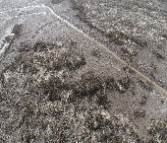 | 灰黑, 光滑 Grayish-black and smooth in texture |  | 2023.04 |
| 糙叶薹草 Carex scabrifolia | 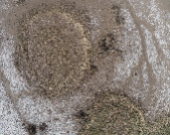 | 灰黄, 光滑 Gray-yellow and smooth in texture | 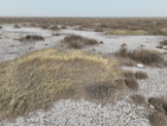 | 2023.04 |
| 芦苇 Phragmites australis | 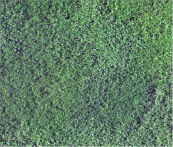 | 墨绿色, 粗糙 Dark green and rough in texture | 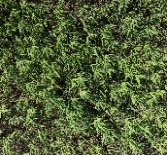 | 2023.08 |
| 芦苇 Phragmites australis |  | 黑色, 粗糙 Near-black and rough in texture |  | 2023.11 |
| 互花米草 Spartina alterniflora | 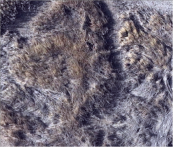 | 灰色, 较光滑 Gray and relatively smooth in texture | 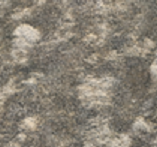 | 2024.08 |
| 碱蓬 Suaeda glauca | 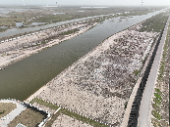 | 红黑, 粗糙 Reddish-black and rough in texture | 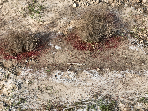 | 2023.04 |
| 碱蓬 Suaeda glauca | 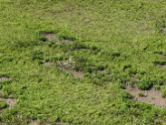 | 连片, 绿色, 光滑 Continuously distributed with a green and smooth in texture | 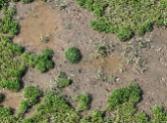 | 2024.08 |
| 光滩 Mudflat | 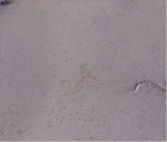 | 土灰色, 相对光滑 Soil-gray and a relatively smooth in texture |  | 2024.08 |
Table 1 Land surface feature information based on unmanned aerial vehicle (UAV) visible-light images at multiple temporal scales
| 地物类别 Land cover types | 影像特征 Image features | 现场特征 Site features | 成像时间 Imaging time | |
|---|---|---|---|---|
| 影像缩略图 Image thumbnail | 特征描述 Characterization | 现场照片缩略图 Site photo thumbnail | ||
| 互花米草 Spartina alterniflora |  | 灰黑, 光滑 Grayish-black and smooth in texture |  | 2023.04 |
| 糙叶薹草 Carex scabrifolia |  | 灰黄, 光滑 Gray-yellow and smooth in texture |  | 2023.04 |
| 芦苇 Phragmites australis |  | 墨绿色, 粗糙 Dark green and rough in texture |  | 2023.08 |
| 芦苇 Phragmites australis |  | 黑色, 粗糙 Near-black and rough in texture |  | 2023.11 |
| 互花米草 Spartina alterniflora |  | 灰色, 较光滑 Gray and relatively smooth in texture |  | 2024.08 |
| 碱蓬 Suaeda glauca |  | 红黑, 粗糙 Reddish-black and rough in texture |  | 2023.04 |
| 碱蓬 Suaeda glauca |  | 连片, 绿色, 光滑 Continuously distributed with a green and smooth in texture |  | 2024.08 |
| 光滩 Mudflat |  | 土灰色, 相对光滑 Soil-gray and a relatively smooth in texture |  | 2024.08 |
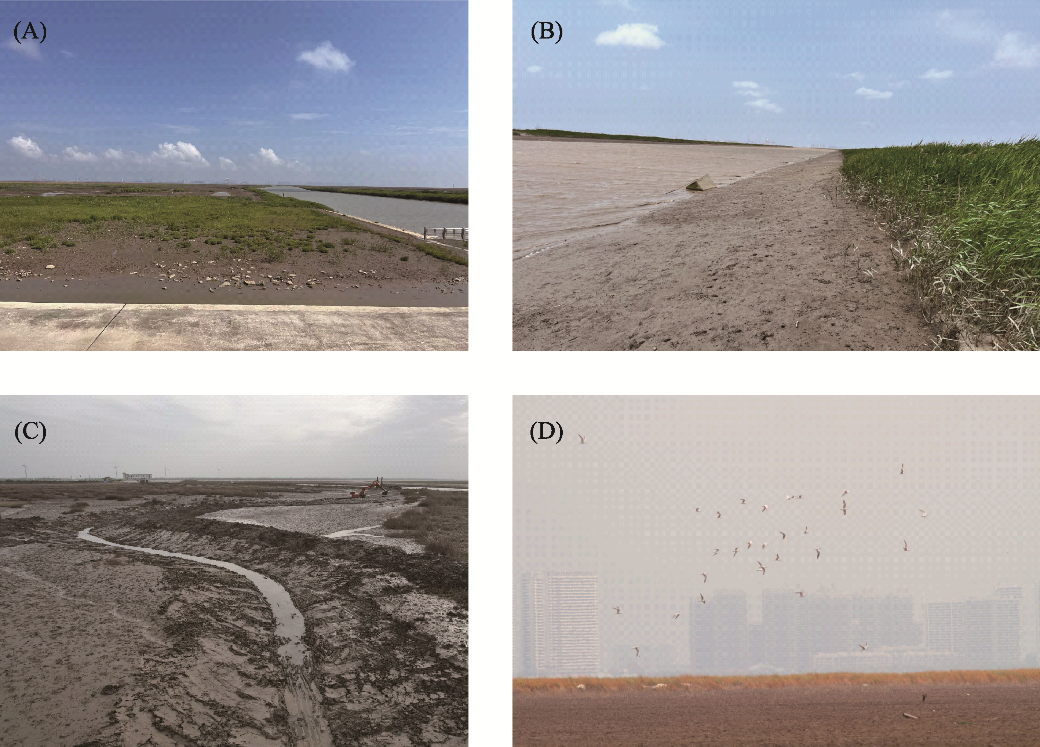
Fig. 4 Current situation of the area after ecological restoration project in the North Branch of Yangtze River Estuary. (A) Native salt marsh vegetation restoration; (B) Flexible slope protection technology; (C) Tidal creek construction; (D) Mudflat construction.
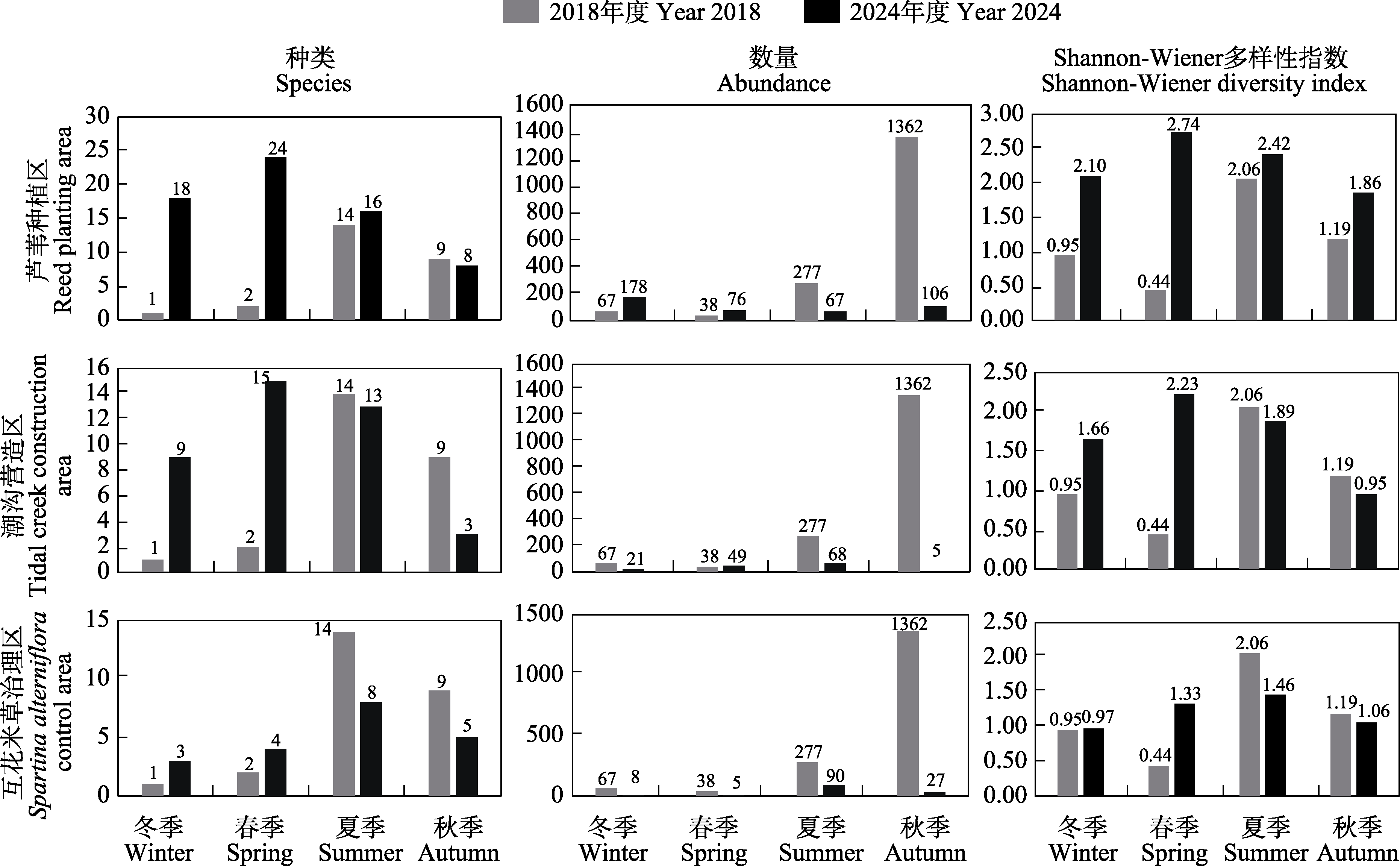
Fig. 8 Comparison of bird community structure characteristics in each region before and after ecological restoration of the North Branch of Yangtze River Estuary
| 物种 Species | 保护级别 Protection level | 芦苇种植区 Reed planting area | 潮沟营造区 Tidal creek construction area | 互花米草治理区 Spartina alterniflora control area | |
|---|---|---|---|---|---|
| 雁形目 Anseriformes | |||||
| 鸭科 Anatidae | |||||
| 斑嘴鸭 Anas zonorhyncha | - | 47 | 2 | 0 | |
| 绿头鸭 Anas platyrhynchos | - | 73 | 0 | 1 | |
| 翘鼻麻鸭 Tadorna tadorna | - | 20 | 0 | 0 | |
| 鸡形目 Galliformes | |||||
| 雉科 Phasianidae | |||||
| 雉鸡 Phasianus colchicus | - | 1 | 0 | 0 | |
| 鹳形目 Ciconiformes | |||||
| 鹳科 Ciconiidae | |||||
| 东方白鹳 Ciconia boyciana | I | 2 | 0 | 0 | |
| 鹈形目 Pelecaniformes | |||||
| 鹮科 Threskiorothidae | |||||
| 白琵鹭 Platalea leucorodia | II | 2 | 3 | 0 | |
| 鹭科 Ardeidae | |||||
| 夜鹭 Nycticorax nycticorax | - | 2 | 5 | 0 | |
| 牛背鹭 Bubulcus coromandus | - | 3 | 1 | 0 | |
| 苍鹭 Ardea cinerea | - | 21 | 12 | 14 | |
| 大白鹭 Ardea alba | - | 3 | 3 | 0 | |
| 中白鹭 Ardea intermedia | - | 1 | 0 | 0 | |
| 白鹭 Egretta garzetta | - | 57 | 6 | 6 | |
| 鲣鸟目 Suliformes | |||||
| 鸬鹚科 Phalacrocoracidae | |||||
| 普通鸬鹚 Phalacrocorax carbo | - | 18 | 3 | 0 | |
| 鹰形目 Accipitriformes | |||||
| 鹗科 Pandionidae | |||||
| 鹗 Pandion haliaetus | II | 0 | 0 | 2 | |
| 鹰科 Accipitridae | |||||
| 黑翅鸢 Elanus caeruleus | II | 1 | 0 | 0 | |
| 白尾鹞 Circus cyaneus | II | 0 | 1 | 0 | |
| 普通鵟 Buteo japonicus | II | 1 | 0 | 0 | |
| 鸻形目 Charadriiformes | |||||
| 反嘴鹬科 Recurvirostridae | |||||
| 反嘴鹬 Recurvirostra avosetta | - | 14 | 0 | 14 | |
| 金眶鸻 Charadrius dubius | - | 5 | 0 | 0 | |
| 环颈鸻 Charadrius alexandrinus | - | 1 | 5 | 0 | |
| 燕鸻科 Glareolidae | |||||
| 普通燕鸻 Glareola maldivarum | - | 5 | 0 | 0 | |
| 鹬科 Scolopacidae | |||||
| 中杓鹬 Numenius phaeopus | - | 5 | 8 | 1 | |
| 翻石鹬 Arenaria interpres | II | 1 | 0 | 0 | |
| 大滨鹬 Calidris tenuirostris | II | 12 | 0 | 0 | |
| 红颈滨鹬 Calidris ruficollis | - | 1 | 0 | 0 | |
| 黑腹滨鹬 Calidris alpina | - | 5 | 0 | 0 | |
| 矶鹬 Actitis hypoleucos | - | 7 | 2 | 0 | |
| 红脚鹬 Tringa totanus | - | 2 | 0 | 0 | |
| 翘嘴鹬 Xenus cinereus | - | 10 | 0 | 0 | |
| 鹤鹬 Tringa erythropus | - | 50 | 0 | 0 | |
| 青脚鹬 Tringa nebularia | - | 11 | 5 | 1 | |
| 鸥科 Laridae | |||||
| 黑嘴鸥 Saundersilarus saundersi | I | 103 | 6 | 118 | |
| 西伯利亚银鸥 Larus vegae | - | 6 | 0 | 0 | |
| 鸥嘴噪鸥 Gelochelidon nilotica | - | 1 | 2 | 0 | |
| 普通燕鸥 Sterna hirundo | - | 7 | 8 | 0 | |
| 须浮鸥 Chlidonias hybrida | - | 3 | 2 | 5 | |
| 白翅浮鸥 Chlidonias leucopterus | - | 2 | 3 | 4 | |
| 鸽形目 Columbiformes | |||||
| 鸠鸽科 Columbidae | |||||
| 珠颈斑鸠 Spilopelia chinensis | - | 2 | 0 | 0 | |
| 鹃形目 Cuculiformes | |||||
| 杜鹃科 Cuculidae | |||||
| 大杜鹃 Cuculus canorus | - | 3 | 1 | 0 | |
| 隼形目 Falconiformes | |||||
| 隼科 Falconidae | |||||
| 红隼 Falco tinnunculus | II | 3 | 0 | 0 | |
| 雀形目 Passeriformes | |||||
| 伯劳科 Laniidae | |||||
| 棕背伯劳 Lanius schach | - | 2 | 1 | 0 | |
| 卷尾科 Dicruridae | |||||
| 黑卷尾 Dicrurus macrocercus | - | 2 | 0 | 0 | |
| 鸦科 Corvidae | |||||
| 喜鹊 Pica serica | - | 0 | 2 | 0 | |
| 燕科 Hirundinidae | |||||
| 家燕 Hirundo rustica | - | 18 | 32 | 10 | |
| 树莺科 Cettiidae | |||||
| 强脚树莺 Horornis fortipes | - | 2 | 0 | 0 | |
| 苇莺科 Acrocephalidae | |||||
| 东方大苇莺 Acrocephalus orientalis | - | 1 | 0 | 0 | |
| 扇尾莺科 Cisticolidae | |||||
| 纯色山鹪莺 Prinia striata | - | 6 | 8 | 0 | |
| 鸦雀科 Paradoxornithidae | |||||
| 棕头鸦雀 Sinosuthora webbiana | - | 1 | 1 | 0 | |
| 震旦鸦雀 Paradoxornis heudei | II | 2 | 0 | 0 | |
| 鹟科 Muscicapidae | |||||
| 北红尾鸲 Phoenicurus auroreus | - | 0 | 2 | 0 | |
| 雀科 Passeridae | |||||
| 麻雀 Passer montanus | - | 2 | 37 | 0 | |
| 鹡鸰科 Motacillidae | |||||
| 白鹡鸰 Motacilla alba | - | 1 | 0 | 0 | |
Table 2 List of birds in each area in 2024
| 物种 Species | 保护级别 Protection level | 芦苇种植区 Reed planting area | 潮沟营造区 Tidal creek construction area | 互花米草治理区 Spartina alterniflora control area | |
|---|---|---|---|---|---|
| 雁形目 Anseriformes | |||||
| 鸭科 Anatidae | |||||
| 斑嘴鸭 Anas zonorhyncha | - | 47 | 2 | 0 | |
| 绿头鸭 Anas platyrhynchos | - | 73 | 0 | 1 | |
| 翘鼻麻鸭 Tadorna tadorna | - | 20 | 0 | 0 | |
| 鸡形目 Galliformes | |||||
| 雉科 Phasianidae | |||||
| 雉鸡 Phasianus colchicus | - | 1 | 0 | 0 | |
| 鹳形目 Ciconiformes | |||||
| 鹳科 Ciconiidae | |||||
| 东方白鹳 Ciconia boyciana | I | 2 | 0 | 0 | |
| 鹈形目 Pelecaniformes | |||||
| 鹮科 Threskiorothidae | |||||
| 白琵鹭 Platalea leucorodia | II | 2 | 3 | 0 | |
| 鹭科 Ardeidae | |||||
| 夜鹭 Nycticorax nycticorax | - | 2 | 5 | 0 | |
| 牛背鹭 Bubulcus coromandus | - | 3 | 1 | 0 | |
| 苍鹭 Ardea cinerea | - | 21 | 12 | 14 | |
| 大白鹭 Ardea alba | - | 3 | 3 | 0 | |
| 中白鹭 Ardea intermedia | - | 1 | 0 | 0 | |
| 白鹭 Egretta garzetta | - | 57 | 6 | 6 | |
| 鲣鸟目 Suliformes | |||||
| 鸬鹚科 Phalacrocoracidae | |||||
| 普通鸬鹚 Phalacrocorax carbo | - | 18 | 3 | 0 | |
| 鹰形目 Accipitriformes | |||||
| 鹗科 Pandionidae | |||||
| 鹗 Pandion haliaetus | II | 0 | 0 | 2 | |
| 鹰科 Accipitridae | |||||
| 黑翅鸢 Elanus caeruleus | II | 1 | 0 | 0 | |
| 白尾鹞 Circus cyaneus | II | 0 | 1 | 0 | |
| 普通鵟 Buteo japonicus | II | 1 | 0 | 0 | |
| 鸻形目 Charadriiformes | |||||
| 反嘴鹬科 Recurvirostridae | |||||
| 反嘴鹬 Recurvirostra avosetta | - | 14 | 0 | 14 | |
| 金眶鸻 Charadrius dubius | - | 5 | 0 | 0 | |
| 环颈鸻 Charadrius alexandrinus | - | 1 | 5 | 0 | |
| 燕鸻科 Glareolidae | |||||
| 普通燕鸻 Glareola maldivarum | - | 5 | 0 | 0 | |
| 鹬科 Scolopacidae | |||||
| 中杓鹬 Numenius phaeopus | - | 5 | 8 | 1 | |
| 翻石鹬 Arenaria interpres | II | 1 | 0 | 0 | |
| 大滨鹬 Calidris tenuirostris | II | 12 | 0 | 0 | |
| 红颈滨鹬 Calidris ruficollis | - | 1 | 0 | 0 | |
| 黑腹滨鹬 Calidris alpina | - | 5 | 0 | 0 | |
| 矶鹬 Actitis hypoleucos | - | 7 | 2 | 0 | |
| 红脚鹬 Tringa totanus | - | 2 | 0 | 0 | |
| 翘嘴鹬 Xenus cinereus | - | 10 | 0 | 0 | |
| 鹤鹬 Tringa erythropus | - | 50 | 0 | 0 | |
| 青脚鹬 Tringa nebularia | - | 11 | 5 | 1 | |
| 鸥科 Laridae | |||||
| 黑嘴鸥 Saundersilarus saundersi | I | 103 | 6 | 118 | |
| 西伯利亚银鸥 Larus vegae | - | 6 | 0 | 0 | |
| 鸥嘴噪鸥 Gelochelidon nilotica | - | 1 | 2 | 0 | |
| 普通燕鸥 Sterna hirundo | - | 7 | 8 | 0 | |
| 须浮鸥 Chlidonias hybrida | - | 3 | 2 | 5 | |
| 白翅浮鸥 Chlidonias leucopterus | - | 2 | 3 | 4 | |
| 鸽形目 Columbiformes | |||||
| 鸠鸽科 Columbidae | |||||
| 珠颈斑鸠 Spilopelia chinensis | - | 2 | 0 | 0 | |
| 鹃形目 Cuculiformes | |||||
| 杜鹃科 Cuculidae | |||||
| 大杜鹃 Cuculus canorus | - | 3 | 1 | 0 | |
| 隼形目 Falconiformes | |||||
| 隼科 Falconidae | |||||
| 红隼 Falco tinnunculus | II | 3 | 0 | 0 | |
| 雀形目 Passeriformes | |||||
| 伯劳科 Laniidae | |||||
| 棕背伯劳 Lanius schach | - | 2 | 1 | 0 | |
| 卷尾科 Dicruridae | |||||
| 黑卷尾 Dicrurus macrocercus | - | 2 | 0 | 0 | |
| 鸦科 Corvidae | |||||
| 喜鹊 Pica serica | - | 0 | 2 | 0 | |
| 燕科 Hirundinidae | |||||
| 家燕 Hirundo rustica | - | 18 | 32 | 10 | |
| 树莺科 Cettiidae | |||||
| 强脚树莺 Horornis fortipes | - | 2 | 0 | 0 | |
| 苇莺科 Acrocephalidae | |||||
| 东方大苇莺 Acrocephalus orientalis | - | 1 | 0 | 0 | |
| 扇尾莺科 Cisticolidae | |||||
| 纯色山鹪莺 Prinia striata | - | 6 | 8 | 0 | |
| 鸦雀科 Paradoxornithidae | |||||
| 棕头鸦雀 Sinosuthora webbiana | - | 1 | 1 | 0 | |
| 震旦鸦雀 Paradoxornis heudei | II | 2 | 0 | 0 | |
| 鹟科 Muscicapidae | |||||
| 北红尾鸲 Phoenicurus auroreus | - | 0 | 2 | 0 | |
| 雀科 Passeridae | |||||
| 麻雀 Passer montanus | - | 2 | 37 | 0 | |
| 鹡鸰科 Motacillidae | |||||
| 白鹡鸰 Motacilla alba | - | 1 | 0 | 0 | |
| [1] | Adam P (2002) Handbook for restoring tidal wetlands. Journal of Experimental Marine Biology and Ecology, 268, 257-259. |
| [2] | Billah MM, Bhuiyan MKA, Islam MA, Das J, Hoque AR (2022) Salt marsh restoration: An overview of techniques and success indicators. Environmental Science and Pollution Research, 29, 15347-15363. |
| [3] | Bowron T, Neatt N, van Proosdij D, Lundholm J, Graham J (2011) Macro-tidal salt marsh ecosystem response to culvert expansion. Restoration Ecology, 19, 307-322. |
| [4] | Breiman L (2001) Machine Learning. Kluwer Academic Publishers, Dordrecht. |
| [5] | Burden A, Garbutt A, Evans CD (2019) Effect of restoration on saltmarsh carbon accumulation in Eastern England. Biology Letters, 15, 20180773. |
| [6] | Cao M (2019) The Dynamics of Birds’ Population and Biodiversity Value Research in Chongming Dongtan Wetland. PhD dissertation, Nanjing Forestry University, Nanjing. (in Chinese with English abstract) |
| [曹牧 (2019) 崇明东滩湿地鸟类种群动态及其多样性价值研究. 博士学位论文, 南京林业大学, 南京.] | |
| [7] | Cao M, Tang CD, Ma Q, Cao Y, Xue JH (2017) Inter-annual population variation of migratory birds in Chongming Dongtan National Nature Reserve. Journal of Nanjing Forestry University (Natural Sciences Edition), 41(1), 15-20. (in Chinese with English abstract) |
|
[曹牧, 汤臣栋, 马强, 曹莹, 薛建辉 (2017) 崇明东滩鸟类国家级自然保护区环志鸟类种群特征年际变化. 南京林业大学学报(自然科学版), 41(1), 15-20.]
DOI |
|
| [8] | Chai ZW, Lei WP, Mo XQ, Que PJ, Shang CH, Yang JW, Zhang ZW (2020) Bird diversity of Beidagang Wetland Nature Reserve in Tianjin City. Wetland Science, 18, 667-678. (in Chinese with English abstract) |
| [柴子文, 雷维蟠, 莫训强, 阙品甲, 尚成海, 阳积文, 张正旺 (2020) 天津市北大港湿地自然保护区的鸟类多样性. 湿地科学, 18, 667-678.] | |
| [9] | Chen P, Zhang Y, Zhu XJ, Lu CH (2019) Ecological effects of invasion by the smooth cordgrass Spartina alterniflora on birds. Acta Ecologica Sinica, 39, 2282-2290. (in Chinese with English abstract) |
| [陈潘, 张燕, 朱晓静, 鲁长虎 (2019) 互花米草入侵对鸟类的生态影响. 生态学报, 39, 2282-2290.] | |
| [10] | Chen XC, Gao RF, Huang XC, Tang JW (2016) Basic views and technological methods of salt marsh restoration and its progresses in implementation. Marine Environmental Science, 35, 467-472. (in Chinese with English abstract) |
| [陈雪初, 高如峰, 黄晓琛, 唐剑武 (2016) 欧美国家盐沼湿地生态恢复的基本观点、技术手段与工程实践进展. 海洋环境科学, 35, 467-472.] | |
| [11] | Choi C, Gan XJ, Hua N, Wang Y, Ma ZJ (2014) The habitat use and home range analysis of Dunlin (Calidris alpina) in Chongming Dongtan, China and their conservation implications. Wetlands, 34, 255-266. |
| [12] | Craft C, Megonigal P, Broome S, Stevenson J, Freese R, Cornell J (2003) The pace of ecosystem development of constructed Spartina alterniflora marshes. Ecological Applications, 13, 1417-1432. |
| [13] | Cutajar J, Shimeta J, Nugegoda D (2012) Impacts of the invasive grass Spartina anglica on benthic macrofaunal assemblages in a temperate Australian saltmarsh. Marine Ecology Progress Series, 464, 107-120. |
| [14] | Dai ZJ, Fagherazzi S, Mei XF, Chen JY, Meng Y (2016) Linking the infilling of the North Branch in the Changjiang (Yangtze) estuary to anthropogenic activities from 1958 to 2013. Marine Geology, 379, 1-12. |
| [15] | Feng HC, Tang LQ, Wang YH, Guo CS, Liu DB, Zhao HM, Zhao LP, Wang WJ (2020) Effects of recent morphological change on the redistribution of flow discharge in the Yangtze River Delta. Continental Shelf Research, 208, 104218. |
| [16] | Gan XJ, Choi C, Wang Y, Ma ZJ, Chen JK, Li B (2010) Alteration of habitat structure and food resources by invasive smooth cordgrass affects habitat use by wintering saltmarsh birds at Chongming Dongtan, East China. The Auk, 127, 317-327. |
| [17] | Genovesi P, Carboneras C, Vilà M, Walton P (2015) EU adopts innovative legislation on invasive species: A step towards a global response to biological invasions? Biological Invasions, 17, 1307-1311. |
| [18] | Guo LC, Xie WM, Xu F, Wang XY, Zhu CY, Meng Y, Zhang WG, He Q (2022) A historical review of sediment export-import shift in the North Branch of Changjiang Estuary. Earth Surface Processes and Landforms, 47, 5-16. |
| [19] | Hagy HM, Hine CS, Horath MM, Yetter AP, Smith RV, Stafford JD (2017) Waterbird response indicates floodplain wetland restoration. Hydrobiologia, 804, 119-137. |
| [20] | He K, Zhang ZY, Song AN, Shen QF, Wang JY, Chen XC (2023) Impact of coastal ecological restoration project on bird diversity and community dynamics. Journal of East China Normal University (Natural Science), (3), 158-166. (in Chinese with English abstract) |
| [贺坤, 张紫菀, 宋桉楠, 沈启帆, 汪嘉怡, 陈雪初 (2023) 海岸带生态修复工程对鸟类多样性及群落动态变化的影响分析. 华东师范大学学报(自然科学版), (3), 158-166.] | |
| [21] | Hu YK, Pang YW, Jiao SW, Huang YX, Xu JF (2019) Temporal and spatial variation of suitable habitat for shorebird in Hangzhou Bay wetland based on remote sensing. Journal of Hangzhou Normal University (Natural Science Edition), 18, 319-328. (in Chinese with English abstract) |
| [胡越凯, 庞毓雯, 焦盛武, 黄雨馨, 徐俊锋 (2019) 基于遥感的杭州湾湿地鸻鹬类水鸟适宜生境时空变化特征研究. 杭州师范大学学报(自然科学版), 18, 319-328.] | |
| [22] | Huang ZJ, Liu JT, Xia DX, Chen XL (2021) The effects of ecological restoration of mangroves on the population dynamics of Ardeid birds in coastal wetlands. Wetland Science & Management, 17(1), 19-22. (in Chinese with English abstract) |
| [黄智君, 刘劲涛, 夏丹霞, 陈小麟 (2021) 滨海湿地红树林生态修复对鹭科鸟类种群动态的影响. 湿地科学与管理, 17(1), 19-22.] | |
| [23] |
Jiang WG, Zhang Z, Ling ZY, Deng YW (2023) Experience and future research trends of wetland protection and restoration in China. Acta Geographica Sinica, 78, 2223-2240. (in Chinese with English abstract)
DOI |
|
[蒋卫国, 张泽, 凌子燕, 邓雅文 (2023) 中国湿地保护修复管理经验与未来研究趋势. 地理学报, 78, 2223-2240.]
DOI |
|
| [24] | Li B, Liao CZ, Zhang XD, Chen HL, Wang Q, Chen ZY, Gan XJ, Wu JH, Zhao B, Ma ZJ, Cheng XL, Jiang LF, Chen JK (2009) Spartina alterniflora invasions in the Yangtze River Estuary, China: An overview of current status and ecosystem effects. Ecological Engineering, 35, 511-520. |
| [25] | Li L, Ji YX, Teng F, Xu SQ (2024) The recent morphological evolution in the upper mouth sandbar of the North Branch and the impacts on its upper reach in the Changjiang Estuary. Marine Geology Frontiers, 40(7), 56-67. (in Chinese with English abstract) |
| [李路, 季永兴, 滕飞, 徐双全 (2024) 长江口北支上口江心沙近期演变及其对北支上段的影响. 海洋地质前沿, 40(7), 56-67.] | |
| [26] | Li YR, Wu HT, Zhang S, Lu X, Lu KL (2021) Morphological characteristics and changes of tidal creeks in coastal wetlands of the Yellow River Delta under Spartina alterniflora invasion and continuous expansion. Wetland Science, 19(1), 88-97. (in Chinese with English abstract) |
| [李昱蓉, 武海涛, 张森, 卢霞, 芦康乐 (2021) 互花米草入侵和持续扩张下黄河三角洲滨海湿地潮沟的形态特征及其变化. 湿地科学, 19(1), 88-97.] | |
| [27] | Li ZP, Zhu JR (2022) Numerical simulation of the North Branch regime change impact on saltwater intrusion in the Yangtze River Estuary from 2007 to 2016. Journal of East China Normal University (Natural Science), (3), 109-124. (in Chinese with English abstract) |
| [李志鹏, 朱建荣 (2022) 2007-2016年北支河势变化对长江口盐水入侵影响数值研究. 华东师范大学学报(自然科学版), (3), 109-124.] | |
| [28] | Liu J, Niu JY, Zou YA, Lu S, Wang TH (2015) Changes in the waterbird community of the ecological restored wetlands in Pudong Dongtan, Shanghai. Resources and Environment in the Yangtze Basin, 24, 219-226. (in Chinese with English abstract) |
| [刘晶, 牛俊英, 邹业爱, 路珊, 王天厚 (2015) 上海浦东东滩鸟类栖息地生态修复区的水鸟群落变化. 长江流域资源与环境, 24, 219-226.] | |
| [29] | Liu N, Dai XH, Wang J, Xie D (2023) Restoration practices and studies of habitat restoration based on natural solutions: A case study of Tianfu National Wetland Park. Wetland Science & Management, 19(5), 86-89. (in Chinese with English abstract) |
| [刘宁, 戴小华, 王洁, 谢冬 (2023) 基于自然解决方案的栖息地修复实践与研究——以天福国家湿地公园为例. 湿地科学与管理, 19(5), 86-89.] | |
| [30] |
Ma KP (2023) Kunming-Montreal Global Biodiversity Framework: An important global agenda for biodiversity conservation. Biodiversity Science, 31, 23133. (in Chinese)
DOI |
|
[马克平 (2023) 《昆明-蒙特利尔全球生物多样性框架》是重要的全球生物多样性保护议程. 生物多样性, 31, 23133.]
DOI |
|
| [31] | Ma ZJ, Gan XJ, Cai YT, Chen JK, Li B (2011) Effects of exotic Spartina alterniflora on the habitat patch associations of breeding saltmarsh birds at Chongming Dongtan in the Yangtze River estuary, China. Biological Invasions, 13, 1673-1686. |
| [32] | Messarosr C, Woolley GS, Morgan MJ (2012) The Function of Ecosystems. In Tech, Croatia. |
| [33] | Mistry J, Berardi A, Simpson M (2008) Birds as indicators of wetland status and change in the North Rupununi, Guyana. Biodiversity and Conservation, 17, 2383-2409. |
| [34] | Mitsch WJ (1993) Ecological engineering: A cooperative role with the planetary life-support system. Environmental Science & Technology, 27, 438-445. |
| [35] | Mitsch WJ (2014) When will ecologists learn engineering and engineers learn ecology? Ecological Engineering, 65, 9-14. |
| [36] | Schrift AM, Mendelssohn IA, Materne MD (2008) Salt marsh restoration with sediment-slurry amendments following a drought-induced large-scale disturbance. Wetlands, 28, 1071-1085. |
| [37] | Shao YC, Liu Y, Zhou X, Wang XY, Lü ZJ, Wu DA (2024) Effect of topographic change on inverted brine in North Branch of the Yangtze Estuary. Urban Roads Bridges & Flood Control, (4), 1-7. (in Chinese with English abstract) |
| [邵雨辰, 刘懿, 周先, 王翔宇, 吕紫君, 吴德安 (2024) 长江口北支地形变化对倒灌盐水的影响. 城市道桥与防洪, (4), 1-7.] | |
| [38] | Strong DR, Ayres DR (2013) Ecological and evolutionary misadventures of Spartina. Annual Review of Ecology, Evolution, and Systematics, 44, 389-410. |
| [39] | Sun CZ, Zhen L, Wang C, Yan BY, Cao XC, Wu RZ (2015) Impacts of ecological restoration and human activities on habitat of overwintering migratory birds in the wetland of Poyang Lake, Jiangxi Province, China. Journal of Mountain Science, 12, 1302-1314. |
| [40] | Sun SS, Wang YJ, Liu DY, Zhang T, Tian B (2022) Spatial distributions and sources of organic matter and its role in food webs in the Chongming Dongtan mudflats in summer. Marine Environmental Science, 41, 408-415. (in Chinese with English abstract) |
| [孙赛赛, 王玉珏, 刘东艳, 张婷, 田波 (2022) 崇明东滩光滩带夏季有机质空间分布特征、来源组成及食物网作用. 海洋环境科学, 41, 408-415.] | |
| [41] | Teal JM, Weinstein MP (2002) Ecological engineering, design, and construction considerations for marsh restorations in Delaware Bay, USA. Ecological Engineering, 18, 607-618. |
| [42] | Teal JM, Weishar L (2005) Ecological engineering, adaptive management, and restoration management in Delaware Bay salt marsh restoration. Ecological Engineering, 25, 304-314. |
| [43] | Temmerman S, Meire P, Bouma TJ, Herman PM, Ysebaert T, Vriend HJD (2013) Ecosystem-based coastal defence in the face of global change. Nature, 504, 79-83. |
| [44] | van Proosdij D, Lundholm J, Neatt N, Bowron T, Graham J (2010) Ecological re-engineering of a freshwater impoundment for salt marsh restoration in a hypertidal system. Ecological Engineering, 36, 1314-1332. |
| [45] | Vandenbruwaene W, Meire P, Temmerman S (2012) Formation and evolution of a tidal channel network within a constructed tidal marsh. Geomorphology, 151, 114-125. |
| [46] | Weishar LL, Teal JM, Hinkle R (2005) Designing large-scale wetland restoration for Delaware Bay. Ecological Engineering, 25, 231-239. |
| [47] |
Whitfield AK (2020) Littoral habitats as major nursery areas for fish species in estuaries: A reinforcement of the reduced predation paradigm. Marine Ecology Progress Series, 649, 219-234.
DOI |
| [48] | Xiao XW, Yu XB, Pan MQ (2012) Implementation and implications of everglade wetland restoration plan in southern Florida, USA. Wetland Science & Management, 8(3), 31-35. (in Chinese with English abstract) |
| [肖协文, 于秀波, 潘明麒 (2012) 美国南佛罗里达大沼泽湿地恢复规划、实施及启示. 湿地科学与管理, 8(3), 31-35.] | |
| [49] |
Xu J, Wang JZ (2023) Analysis of the main elements and implications of the Kunming-Montreal Global Biodiversity Framework. Biodiversity Science, 31, 23020. (in Chinese with English abstract)
DOI |
|
[徐靖, 王金洲 (2023) 《昆明-蒙特利尔全球生物多样性框架》主要内容及其影响. 生物多样性, 31, 23020.]
DOI |
|
| [50] | Xu L, Li B, Yuan X, Xu HF (2006) The characteristics of the avian community in Chongming Dongtan spring 2003. Chinese Journal of Zoology, 41(6), 120-126. (in Chinese with English abstract) |
| [徐玲, 李波, 袁晓, 徐宏发 (2006) 崇明东滩春季鸟类群落特征. 动物学杂志, 41(6), 120-126.] | |
| [51] | Yang W, Qiao YJ, Li N, Zhao H, Yang R, Leng X, Cheng XL, An SQ (2017) Seawall construction alters soil carbon and nitrogen dynamics and soil microbial biomass in an invasive Spartina alterniflora salt marsh in Eastern China. Applied Soil Ecology, 110, 1-11. |
| [52] | Yuan ZS, Xing JH, Qiao HJ, Yang L, Song G (2022) Rapid bird diversity survey based on simultaneous counting and zoned direct number methods—A case of wetland birds’ monitoring in Lalu, 2020 winter. Plateau Science Research, 6(3), 45-52. (in Chinese with English abstract) |
| [袁志胜, 邢家华, 乔慧捷, 杨乐, 宋刚 (2022) 基于同步计数和分区直数法相结合的鸟类多样性快速调查——以2020年冬季拉鲁湿地监测为例. 高原科学研究, 6(3), 45-52.] | |
| [53] | Zhang B, Yuan X, Pei EL, Niu JY, Heng NN, Wang TH (2011) Change of waterbird community structure after the intertidal mudflat reclamation in the Yangtze River Mouth: A case study of Nanhui Dongtan area. Acta Ecologica Sinica, 31, 4599-4608. (in Chinese with English abstract) |
| [张斌, 袁晓, 裴恩乐, 牛俊英, 衡楠楠, 王天厚 (2011) 长江口滩涂围垦后水鸟群落结构的变化——以南汇东滩为例. 生态学报, 31, 4599-4608.] | |
| [54] |
Zhang QQ, Han GX, Lu F, Zhou YF, Wang XJ, Li PG, Chu XJ, He WJ, Yu DX, Song WM, Xu JW (2022) Effects of different restoration ages on plant diversity and community stability of wetlands in the Yellow River Delta. Chinese Journal of Ecology, 41, 1249-1257. (in Chinese with English abstract)
DOI |
| [张奇奇, 韩广轩, 路峰, 周英锋, 王晓杰, 李培广, 初小静, 贺文君, 于冬雪, 宋维民, 许景伟 (2022) 不同修复年限对黄河三角洲湿地植物多样性和群落稳定性的影响. 生态学杂志, 41, 1249-1257.] | |
| [55] | Zhao ZY, Zhang LQ, Li XZ, Yuan L, Bouma T (2021) The onset of secondary seed dispersal is controlled by germination-features: A neglected process in sudden saltmarsh establishment. Limnology and Oceanography, 66, 3070-3084. |
| [56] | Zhou WH, Zhu JH, Liu HX, Liu DY, Wen D (2018) Overview of wetland bird survey methods. Chinese Journal of Wildlife, 39, 588-593. (in Chinese with English abstract) |
| [周雯慧, 朱京海, 刘合鑫, 刘冬烨, 问鼎 (2018) 湿地鸟类调查方法概述. 野生动物学报, 39, 588-593.] | |
| [57] | Zhu H, Wu HT, Xing XX, Xie T, Song CC, Wang GD, Jiang M (2023) Achievement of wetland protection and restoration and development strategies in China. Bulletin of Chinese Academy of Sciences, 38, 365-375. (in Chinese with English abstract) |
| [祝惠, 武海涛, 邢晓旭, 谢天, 宋长春, 王国栋, 姜明 (2023) 中国湿地保护修复成效及发展策略. 中国科学院院刊, 38, 365-375.] | |
| [58] | Zuo P, Zhao SH, Liu CA, Wang CH, Liang YB (2012) Distribution of Spartina spp. along China’s coast. Ecological Engineering, 40, 160-166. |
| [1] | Yan Kang, Jing Gan, Linlin Yu, Chenjing He, Liqing Zhang, Jingbin Wu. Design pattern and network development of urban microhabitat based on nature-based solutions (NbS): A case study of habitat gardens in Changning District, Shanghai [J]. Biodiv Sci, 2025, 33(5): 24528-. |
| [2] | Zhang Mingyi, Wang Xiaomei, Zheng Yanxin, Wu Nan, Li Donghao, Fan Enyuan, Li Na, Shan Xiujuan, Yu Tao, Zhao Chunnuan, Li Bo, Xu Shuai, Wu Yuping, Ren Liqun. Resource status and habitat function of typical oyster reef areas in the Yellow River Estuary [J]. Biodiv Sci, 2025, 33(4): 24208-. |
| [3] | Fei Duan, Mingzhang Liu, Hongliang Bu, Le Yu, Sheng Li. Effects of urbanization on bird community composition and functional traits: A case study of the Beijing-Tianjin-Hebei region [J]. Biodiv Sci, 2024, 32(8): 23473-. |
| [4] | Rongfei Su, Ruishan Chen, Linlin Yu, Jingbin Wu, Yan Kang. Biodiversity in community habitat gardens in Changning District, Shanghai based on camera trapping [J]. Biodiv Sci, 2024, 32(8): 24068-. |
| [5] | Haotian Bai, Shang Yu, Xinyuan Pan, Jiale Ling, Juan Wu, Kaiqi Xie, Yang Liu, Xueye Chen. AI-assisted recognition for passive acoustic monitoring of birds in urban wetland parks [J]. Biodiv Sci, 2024, 32(8): 24188-. |
| [6] | Jiaqi Li, Yidi Feng, Lei Wang, Penyan Pan, Xiaoru Liu, Xueyang Li, Yihan Wang, Fang Wang. Diet and habitat selection of raccoon dogs (Nyctereutes procyonoides) in Shanghai, a rapidly urbanizing megacity in eastern China [J]. Biodiv Sci, 2024, 32(8): 24131-. |
| [7] | Mingjun Zhang, Hesheng Wang, Wenbo Yan, Yunnan Fu, Qi Wang, Zhigao Zeng. Diel activity and habitat selection of small Indian civets (Viverricula indica) in Hainan Datian National Nature Reserve [J]. Biodiv Sci, 2024, 32(6): 23420-. |
| [8] | Peng Wang, Jiarong Sui, Xinyao Ding, Weizhong Wang, Xueqian Cao, Haipeng Zhao, Yanping Wang. Nested distribution patterns of bird assemblages and their influencing factors in Zhengzhou urban parks [J]. Biodiv Sci, 2024, 32(3): 23359-. |
| [9] | Chunxiao Wang, Zhengwang Zhang, Shaoxia Xia, Houlang Duan, Wen Wang, Yifei Jia, Lixun Zhang, Gang Feng, Yaqiao Yang, Tong Li, Changqing Ding, Chunping Wang, Baodong Yuan, Jinyu Lei, Yu Liu, Jianbin Shi, Keqi Lan, Qingqing Shi, Qing Xiao, Xiubo Yu. Seasonal and regional patterns and conservation strategies of waterbird diversity in the Yellow River Basin [J]. Biodiv Sci, 2024, 32(11): 23490-. |
| [10] | Zezhou Hao, Chengyun Zhang, Le Li, Bingtao Gao, Wei Zeng, Chun Wang, Zixuan Wang, Wantao Huang, Yue Zhang, Nancai Pei, Zhishu Xiao. Applications of passive acoustic monitoring and evaluation in urban bird research [J]. Biodiv Sci, 2024, 32(10): 24123-. |
| [11] | Le Li, Chengyun Zhang, Nancai Pei, Bingtao Gao, Na Wang, Jiarui Li, Ruichen Wu, Zezhou Hao. Correlation analysis of urban green landscape patterns and bird diversity based on passive acoustic monitoring technology [J]. Biodiv Sci, 2024, 32(10): 24296-. |
| [12] | Haolin Wang, Huaisheng Zhang, Jianqiang Zhu, Zhongyi Chen, Yulin Ke, Tao Yang, Hui Chen. Research progress of diet composition and its research methods for Père David’s deer [J]. Biodiv Sci, 2024, 32(1): 23057-. |
| [13] | Churan Zhang, Shengfa Li, Fengchang Li, Zhizhong Tang, Huiyan Liu, Lihong Wang, Rong Gu, Yun Deng, Zhiming Zhang, Luxiang Lin. Habitat association and community classification of woody plants in the 20 ha forest dynamics plot of subtropical semi-humid evergreen broad-leaved forest in the Jizu Mountains, Yunnan [J]. Biodiv Sci, 2024, 32(1): 23393-. |
| [14] | Cailian Liu, Xiong Zhang, Enyuan Fan, Songlin Wang, Yan Jiang, Baian Lin, Lu Fang, Yuqiang Li, Lebin Liu, Min Liu. Species diversity, ecological characteristics and conservation measures of seahorses (Hippocampus) in China’s waters [J]. Biodiv Sci, 2024, 32(1): 23282-. |
| [15] | Shuhan Yang, He Wang, Lei Chen, Yingfei Liao, Guang Yan, Yining Wu, Hongfei Zou. Effects of heterogeneous habitat on soil nematode community characteristics in the Songnen Plain [J]. Biodiv Sci, 2024, 32(1): 23295-. |
| Viewed | ||||||
|
Full text |
|
|||||
|
Abstract |
|
|||||
Copyright © 2022 Biodiversity Science
Editorial Office of Biodiversity Science, 20 Nanxincun, Xiangshan, Beijing 100093, China
Tel: 010-62836137, 62836665 E-mail: biodiversity@ibcas.ac.cn ![]()